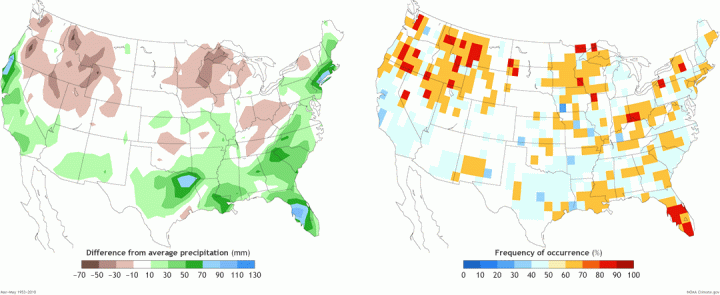News•March 6, 2015
Maps Show El Niño Won't Help the West’s Water Woes

By Brian Kahn
El Niño has finally proved the haters wrong. After months of being derided as “El Limbo” and “El No Show,” scientists declared the phenomenon here almost a year to the day after declaring an El Niño Watch.
Sure, it’s later and wimpier than initial forecasts, but better late and weaker than never. Unless of course, you hoped for an end to the suffering from drought in the western U.S.
Californians were counting on El Niño to arrive in the winter wet season and help bust drought. That didn’t happen and, as two maps published by Climate.gov show, the spring arrival doesn’t pack nearly enough punch to help bring the region out of drought.
Change in precipitation and the frequency with which it occurs based on spring El Niño patterns.
Click image to enlarge. Credit: Climate.gov

The maps show both the average change in precipitation over all 10 years with spring El Niños and how often that pattern played out. Parts of the Southwest and California can see the fabled El Niño bump, but the odds of it happening are 50-50 or less.
That’s unfortunate news for California, where a recent survey of snow-water content in the Sierra Nevada revealed it is the lowest on record for this time of year. Estimates from early February show that parts of California would have needed 1,004 percent (yes, over one thousand percent) of its monthly rainfall to break the drought, so even with an El Niño boost, emerging from drought is unlikely.
The news for the Northwest, which has seen the slow creep of drought across the region over the past year, is even worse. Spring El Niños tend to lead to lower precipitation (bad) and the frequency of that occurring is anywhere from 60-90 percent (worse). The region’s snowpack has been nearly as dismal as California’s this winter.
All this means that El Niño is unlikely to usher in a March Miracle (or a March-May Miracle, for that matter) and might even bring some Spring Suffering to the Northwest.
You May Also Like:
Solar Energy Jobs Growing By Leaps and Bounds
After Much Ado, El Niño Officially Declared
Arctic Sea Ice Is Getting Thinner, Faster
How Did Your City Fare This Winter?